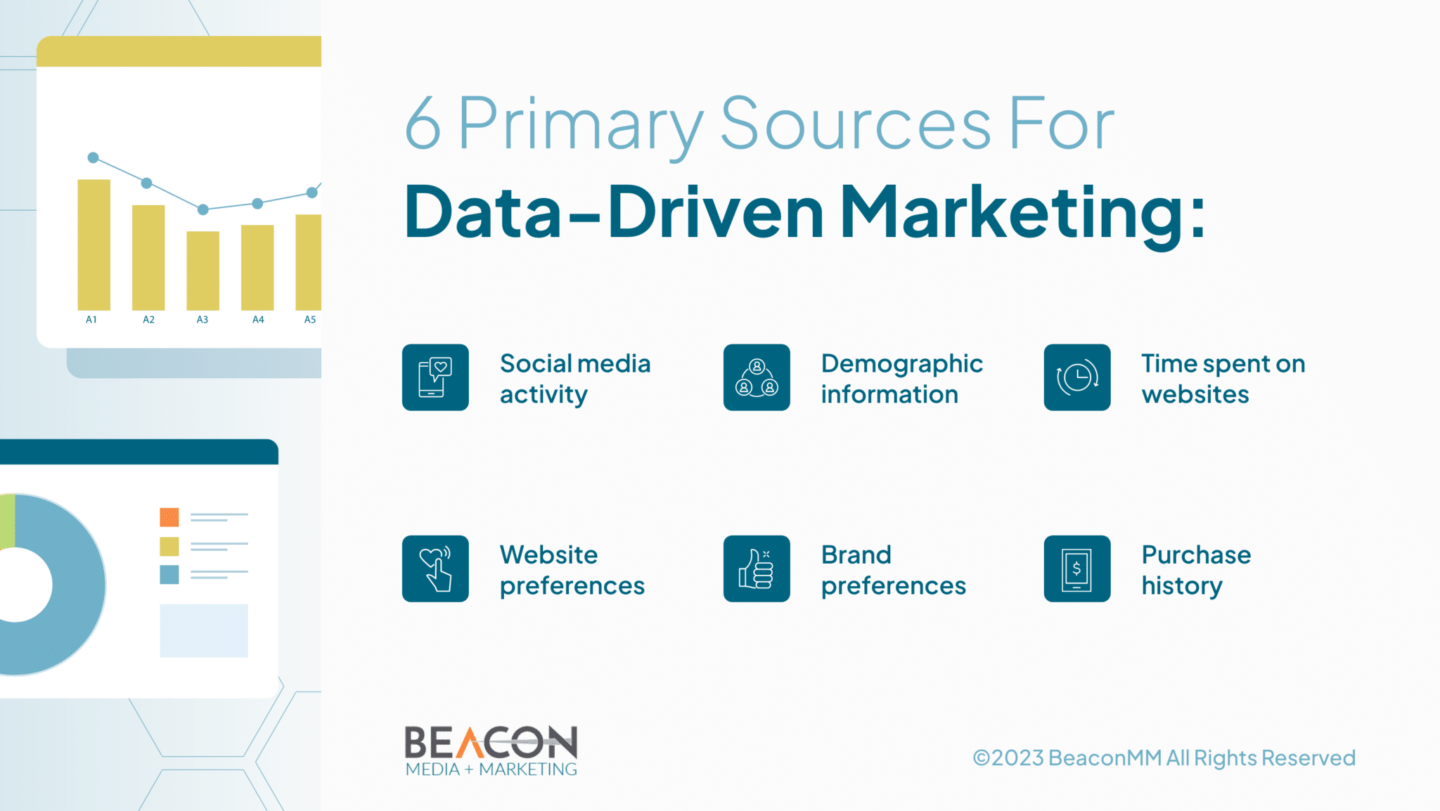Following the onset of COVID-19, marketers nationwide began scratching their heads. This is because, between March and August of 2020, reporting showed that one in five consumers hopped to a different brand, and seven in ten consumers began exploring new shopping channels. However, the data collected ultimately led marketers to rethink their tech and data strategy as related to precision marketing – initiating a new wave of data-driven marketing.
The fact is, even though these reports showed us that data models need to change alongside consumer trends, many companies have continued to rely on outdated data modeling – even three years after the pandemic. In a world where trends set standards, you have to be prepared to adapt quickly.
While some marketers rely on mass marketing strategies in place of trusting or improving data modeling, this tactic will only lead to stagnant sales and snailish growth. As such, the value of data, analytics, and reporting cannot be overstated in an environment where marketing meets constant consumer change.
Ready to Learn more about how data-driven marketing can improve your overall marketing strategy? Reach out to Beacon Media + Marketing today to learn more.
Why Is Data-Driven Marketing so Valuable?
In today’s digital age, data is more important than ever before. It is the fuel that powers and guides most businesses, and it is an essential tool for marketing teams looking to reach their target audience and achieve their goals.
The ability to collect and analyze data has become a key competitive advantage for businesses of all sizes, and it can be used to inform your marketing strategies and drive better business outcomes.
At the end of the day, data-driven marketing is simply a strategy that relies on the analysis of data and the use of insights to inform marketing decisions. And with the growing volume of data being generated every day, businesses have access to a wealth of information that can be used to better understand their customers and improve their marketing efforts.
The Value of Data

Data is the foundation of data-driven marketing – hence the name. The more data a business can acquire, the better it can understand its customers – including their needs and preferences. And by measuring the right data, businesses can make informed and calculated decisions that lead to increased customer engagement, loyalty, and revenue.
One of the primary sources of data for data-driven marketing is consumer data. This often includes:
- Demographic information
- Purchase history
- Website preferences
- Brand preferences
- Time spent on websites
- Social media activity
By analyzing this data, you can create detailed customer profiles that help you to understand who your customers are, how and when they shop, where they shop, and most importantly, what they want.
Another great source is marketing data. And this includes a range of data collected from marketing campaigns including:
- Email open rates
- Click-through rates
- Bounce rates
- Conversion rates
By drilling down into this data, businesses can easily identify which marketing campaigns are most effective and make changes to improve future campaigns.
Value of Analytics
Analytics refers to the process of analyzing data to uncover insights that can inform your marketing decisions. And analytics allows businesses to identify key patterns, trends, and correlations in data that may not be immediately apparent. All in all, analytics is where the magic happens – illustrating how you can leverage data to scale any campaign.
One of the most common types of analytics used in data-driven marketing is predictive analytics. This process uses statistical algorithms and machine learning to identify patterns in data that can be used to predict future outcomes. For example, businesses can use predictive analytics to identify which customers are most likely to make a purchase in the future. And as AI marketing tools continue to evolve, this will only become more accurate.
Another type of analytics is descriptive analytics. Here, the focus is on summarizing and visualizing data to provide insights into what has happened in the past. And this can be useful for identifying trends and patterns in customer behavior that can inform marketing decisions.
Value of Reporting
Reporting is the process of presenting data and insights in a way that is easy to understand and act upon. In the most fundamental sense, reporting allows you to digest and communicate the results of your analytics efforts to stakeholders – and make data-driven decisions based on those results.
One of the most important aspects of reporting is data visualization. And this process allows businesses to present data in a way that is easy to understand and interpret. It can include graphs, charts, and other visual aids that help stakeholders quickly understand the insights presented. For example, a quality data-driven report may include the following information:
- Impressions The number of times an ad or piece of content was displayed.
- Clicks: The number of times someone clicked on an ad or a piece of content.
- Click-through rate (CTR): The percentage of people who clicked on an ad or a piece of content after seeing it.
- Conversion Rate: The percentage of people who completed a desired action, such as making a purchase or filling out a form, after clicking on an ad or a piece of content.
- Cost Per Click (CPC): The amount of money spent on each click.
- Cost Per Acquisition (CPA): The amount of money spent on each conversion.
- Return On Investment (ROI): The amount of revenue generated from a marketing campaign compared to the amount of money spent on the campaign.
- Engagement Rate: The percentage of people who interacted with a piece of content, such as liking or commenting on a social media post.
- Reach: The number of unique people who saw a piece of content.
- Bounce Rate: The percentage of people who visited a website but left after viewing only one page.
- Average Session Duration: The average length of time that people spend on a website.
- Revenue: The total amount of money generated from a marketing campaign.
- Customer Lifetime Value (CLV): The predicted amount of money that a customer will spend on a company’s products or services over their lifetime.
- Customer Acquisition Cost (CAC): The amount of money spent to acquire a new customer.
- Net Promoter Score (NPS): A customer satisfaction metric that measures the likelihood of customers recommending a company’s products or services to others.
Another important aspect of reporting is the ability to customize reports for different stakeholders. Different stakeholders may have different needs and interests, so it’s critical to create reports that are tailored to their specific needs.
How to Execute Data-Driven Marketing Strategies
All in all, data-driven marketing is a powerful strategy that can help businesses better understand their customers and improve their marketing efforts. By leveraging the value of data, analytics, and reporting, businesses can make informed decisions that lead to increased customer engagement, loyalty, and revenue.
Identify Your Target Audience
One of the most significant advantages of using data in marketing is the ability to identify your target audience. Data analytics tools can provide insights into customer demographics, behaviors, and preferences, allowing businesses to develop targeted marketing campaigns that resonate with their ideal customers.
By analyzing data on customer behavior and preferences, businesses can tailor their marketing efforts to reach their target audience more effectively. They can identify which channels their customers prefer, which types of content they respond to, and which products or services they are most interested in.
Measure the Effectiveness of Your Marketing Campaigns
Data can also be used to measure the effectiveness of marketing campaigns. By analyzing data on key performance indicators (KPIs), such as website traffic, click-through rates, conversion rates, and sales, businesses can determine which marketing channels and tactics are working and which ones need to be improved.
Data can also provide insights into customer engagement and retention rates, allowing businesses to develop strategies to retain customers and increase customer lifetime value.
Optimize Your Marketing Strategies
Data can help businesses optimize their marketing strategies by providing insights into customer behavior and preferences. By analyzing data on customer interactions with marketing channels and content, businesses can identify areas for improvement and make adjustments to their marketing strategies.
For example, if a business discovers that its customers are more likely to respond to social media ads than email campaigns, it can reallocate its marketing budget accordingly. Similarly, if a business finds that its customers are more likely to purchase a particular product or service during a specific time of the year, it can adjust its marketing strategy to ensure its advertising efforts are having the biggest impact.
Improve Your Customer Experience
Data can also be used to improve the customer experience. By analyzing data on customer interactions with products, services, and marketing channels, businesses can identify areas for improvement and make changes to improve the customer experience.
In addition, data has long been an essential tool for businesses looking to develop effective marketing strategies and drive better business outcomes. By leveraging data, businesses can identify their target audience, measure the effectiveness of their marketing campaigns, optimize their marketing strategies, and improve the customer experience.
In today’s data-driven world, businesses that do not embrace data are likely to fall behind their competitors. But by leveraging data, businesses can gain a competitive advantage, improve their marketing strategies, and drive better business outcomes.
How to Measure and Optimize Marketing Campaigns Using Data Analytics and Reporting
Again, we cannot overstate the importance of data-driven marketing. In fact, it’s part of the basics of marketing in today’s world. But before you can leverage any data that you collect, or modify it to help you reach target goals, you have to employ a process. The good news is, the process is fairly simple.
Define your campaign goals
Before you start your campaign, you need to define your goals and what you want to achieve. Is it to increase website traffic, generate leads, or boost sales? Defining your goals helps you determine the metrics you need to track.
Choose the right metrics
Once you have defined your goals, you need to choose the right metrics to track. For example, if your goal is to increase website traffic, you may want to track the number of page views, unique visitors, bounce rate, etc. If your goal is to generate leads, you may want to track the number of form submissions, conversion rate, cost per lead, etc.
Set up tracking
Once you have defined your goals and metrics, you need to set up tracking. You can use tools like Google Analytics, Mixpanel, or Kissmetrics to track your campaigns. But you have to be sure to set up tracking correctly to ensure accurate data.
Analyze your data
Once you have collected data, it’s time to analyze it. Use data visualization tools to make sense of your data. Look for trends and patterns and identify areas where you can optimize your campaigns.
Optimize your campaigns
Based on your analysis, make adjustments to your campaigns to optimize them. For example, if you find that a particular ad is not performing well, you can change the targeting, ad copy, or creative to improve its performance.
Report on your results
Finally, report on your results to stakeholders. Use data visualization tools to create reports that are easy to understand. Then, share your insights and recommendations for future campaigns.
By following these steps, you can use data analytics and reporting to measure and optimize your marketing campaigns. And don’t forget to regularly monitor your campaigns to ensure you are on track to achieving your goals.
Improve Data-Driven Marketing With Beacon Media + Marketing
As you can see, the power of data in today’s marketing landscape cannot be overlooked. Without data, you’re basically flying blind, using your gut, and hoping for the best when looking to make your customers happy. And though intuition is a valuable tool in itself, combining this with the power of data-driven marketing will only enhance your chances of success.
At Beacon, we know how to present data effectively. And knowing how to evaluate a digital marketing agency is a great place to start the process of finding an agency that knows how to read data and implement these findings for optimizing marketing performance across all channels.
Our team thrives on data collection – and we use this knowledge to enhance the performance of all marketing campaigns. In an environment where big data is pushing a technological revolution, we’re on the front lines, using it as leverage.
Are you interested in applying data-driven to your overall marketing strategy? Contact Beacon Media + Marketing today to find out more.






